Performance
£429 is a hefty asking price for a netbook, but can ASUS's combination of a dual-core Atom CPU and NVIDIA GPU deliver notebook-like performance?
To find out, we're comparing the system with a wide range of systems. Netbooks are represented by the 10.1in Acer Aspire One D260 and 10.1in MSI Wind U160, whilst notebooks are shown in the form of the 11.6in Dell Inspiron M101z and 13.3in Acer Timeline 3810T. For comparison's sake, we've also thrown in numbers for one of the world's most powerful sub-12in notebooks, the Dell Alienware M11x.
What will be interesting is the head to head match up between the ASUS Eee PC 1215N and Dell Inspiron M101z. Both offer dual-core CPUs and dedicated graphics at a starting price of £429, but one machine favours the Intel + NVIDIA combination, whilst the other is all AMD.
Before we find out which of the two comes out on top, here's a look at the key specifications of all of our comparison notebooks, as well as a brief rundown of the benchmarks we use.
| Comparison systems | ||||||
|---|---|---|---|---|---|---|
| Laptop | Acer Aspire One D260 | MSI Wind U160 | Dell Inspiron M101z | Dell Alienware M11x | ASUS Eee PC 1215N | Acer Timeline 3810T |
| Processor | Intel Atom N450 (1.66GHz, 512KB L2 cache, single-core) | Intel Atom N450 (1.66GHz, 512KB L2 cache, single-core) | AMD Athlon II Neo K325 (1.30GHz, 2MB L2 cache, dual-core) | Intel Core i5 520UM (1.06GHz, 3MB L3 cache, dual-core) | Intel Atom D525 (1.8GHz, 1MB L2 cache, dual-core) | Intel Core 2 Duo SU9400 (1.40GHz, 3MB L2 cache, dual-core) |
| Memory | 1GB DDR2 | 1GB DDR2 | 4GB DDR3 | 4GB DDR3 | 2GB DDR3 | 2GB DDR3 |
| Graphics | Intel GMA 3150 | Intel GMA 3150 | AMD ATI Mobility Radeon HD 4225 | Intel HD Graphics + NVIDIA GeForce GT335M 1GB | Intel GMA 3150 + NVIDIA ION 2 | Intel GMA 4500MHD |
| Graphics driver | Intel 8.14.10.2117 | Intel 8.14.10.2117 | AMD ATI Catalyst 10.7 | Intel 8.15.10.2182 + NVIDIA Verde 257.30 | Intel 8.14.10.2117 + NVIDIA Verde 260.89 | Intel 7.15.10.1666 |
| Display | 10.1in - 1,024x600 | 10in - 1,024x600 | 11.6in - 1,366x768 | 11.6in - 1,366x768 | 12.1in - 1,366x768 | 13.3in - 1,366x768 |
| Battery | 6 cell, 49Whr | 6 cell, 65Whr | 6 cell, 56Whr | 6 cell, 63Whr | 6 cell, 56Whr | 6 cell, 56Whr |
| Weight | 1,202g (including battery) | 1,237g (including battery) | 1,572g (including battery) | 2,010g (including battery) | 1,523g (including battery) | 1,645g (including battery) |
| Wireless | Atheros AR5B95 WiFi (802.11bgn) | Ralink 1T1R (802.11bgn) | Broadcom WLAN Half-Mini Card (802.11bgn) and Bluetooth | Dell DW1520 (802.11bgn) and Bluetooth | Broadcom WiFi (802.11bgn) and Bluetooth | Intel WiFi 5100 (802.11bgn) and Bluetooth |
| Disk drive | Western Digital Scorpio Blue 160GB HDD, 5,400RPM, 8MB cache | Seagate Momentus 250GB HDD, 5,400RPM, 8MB cache | Seagate Momentus 320GB HDD, 7,200RPM, 16MB cache | Samsung 256GB PM800 SSD | Seagate Momentus 250GB HDD, 5,400RPM, 8MB cache | Hitachi 500GB HDD, 5,400RPM, 8MB cache |
| Optical drive | None | None | None | None | None | None |
| Operating System | Microsoft Windows 7 Starter, 32-bit | Microsoft Windows 7 Starter, 32-bit | Microsoft Windows 7 Home premium, 64-bit | Microsoft Windows 7 Home Premium, 64-bit | Microsoft Windows 7 Home Premium, 32-bit | Microsoft Windows 7 Home Premium, 32-bit |
| Approx. price as configured | £250 | £330 | £499 | £1,500 | £429 | £650 |
| Benchmarks | ||||||
| Geekbench 2.1.6 | A cross-platform benchmark used to measure memory and processor performance. Run using high-performance mode. | |||||
| Cinebench 11.5 | Using Cinebench's multi-CPU render, this cross-platform benchmark stresses as many cores as possible. Run using high-performance mode. | |||||
| 3DMark06 | A PC benchmark used to test the DirectX 9 performance of a system's graphics card. Run using high-performance mode. | |||||
| Power consumption | Using balanced power settings, we record mains power draw whilst playing back a 720p movie trailer. | |||||
| Battery test | In order to measure battery life, we run the notebook on balanced power settings and loop a 720p movie trailer, measuring the time taken to hibernate. | |||||
CPU and GPU performance
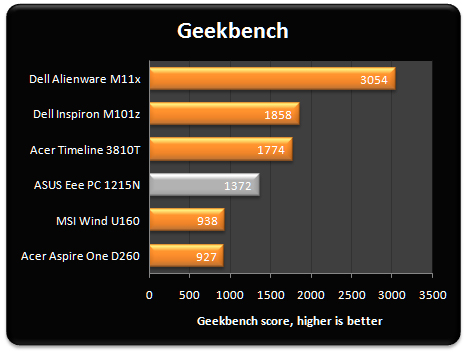
The ASUS Eee PC 1215N's dual-core Intel Atom D525 processor is clearly an improvement on the traditional single-core Intel Atom N450.
But the leap isn't significant enough to challenge other CPUs in the line up. Intel's Atom falls short of AMD's Athlon II Neo, it isn't able to catch the ageing Core 2 Duo ULV, and pales in comparison to a mobile Core i5 part.
It's an improvement as far as netbooks are concerned, but the Intel Atom architecture still offers only basic performance for budget systems.
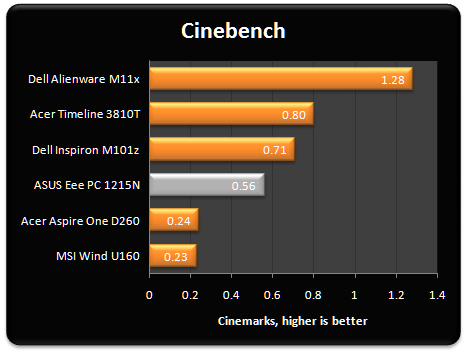
Looking directly at CPU performance, Cinebench sandwiches the ASUS Eee PC 1215N right in between netbooks and notebooks.
Moving on from a single-core Atom N450 to a dual-core Atom D525 has made a world of difference. The combination of an extra hyper-threaded core, a quicker 1.8GHz operating speed and a doubling of L2 cache more than doubles CPU performance - and it shows. During use, the ASUS Eee PC 1215N feels noticeably more responsive than single-core netbooks such as the Acer Aspire One D260.
It's still considerably slower than systems equipped with more powerful processors such as Intel's Core i3 or Core i5, but it doesn't feel painfully sluggish. We had no trouble browsing the web in multiple windows with a 720p video playing happily in the background, though a lot of that is the result of the companion NVIDIA GPU.
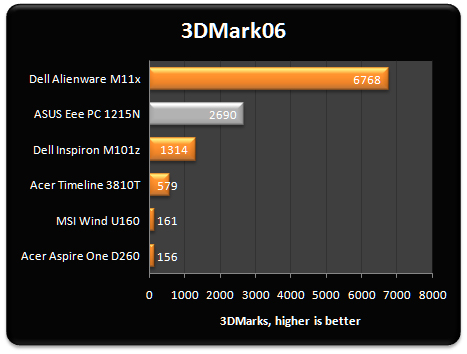
Although NVIDIA is keeping the finer details of its ION 2 graphics processor under wraps, we do know it has up to 16 CUDA cores and can vary depending on OEM requirements.
The chip used in the ASUS Eee PC 1215N appears to have 512MB of dedicated DDR3 graphics memory - as opposed to shared system memory for the original ION chip - and, according to GPU-Z, a core clocked at 475MHz.
How much of a difference does it make? The answer is plenty. Scoring a useful 2,690 3DMarks, the ION 2 chip offers roughly 16 times the performance of Intel's integrated GMA 3150 processor. It also scores over twice as many points as AMD's ATI Mobility Radeon HD 4225.
For a netbook, the numbers are impressive, and the 12.1in system does show signs of basic gaming potential. Frame rates close to 30fps can be achieved in less demanding titles such as World of Warcraft, but modern games will take their toll. Attempting to run Just Cause 2 at a basic 1,024x768 resolution with minimal detail levels returned an average frame rate of 14.47.
Serious gaming might be a step too far, but the ION 2 GPU proves its worth by seamlessly accelerating high-def video. We had no trouble playing back 1080p video files, and we were able to easily push 1080p content to a 50in TV using the netbook's HDMI output. That's something we've never done with a netbook before.
Having the added GPU oomph on tap is certainly useful, but what's particularly rewarding is NVIDIA's Optimus technology. Seamlessly switching between the netbook's integrated Intel GMA 3150 graphics core and NVIDIA's ION 2 processor, it ensures the power-hungry NVIDIA chip is called upon only when needed.
That should bode well for battery life, but there is a potential problem. The 1.8GHz Atom D525 processor used in ASUS's system is designed as a desktop part and carries a TDP of 13W. That's comfortably more than the 8.5W TDP of the slower mobile equivalent, the dual-core 1.5GHz Atom N550. Can the Eee PC 1215N really live up to ASUS's expectations of up to seven hours of battery life?
Power consumption and battery life
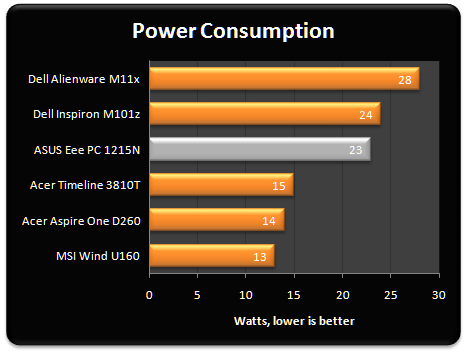
Playing back a 720p video - with the NVIDIA ION 2 GPU called into action - sees the Eee PC 1215N eating up 23W of power, about the same as a Dell Inspiron M101z.
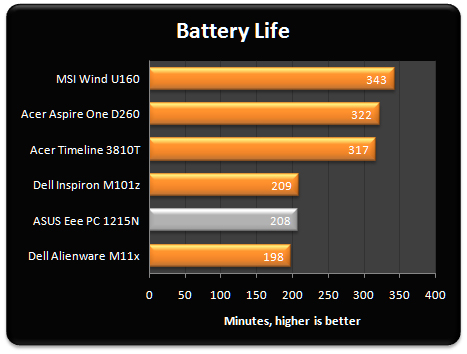
And, with the Dell Inspiron and ASUS Eee PC both using a six-cell battery, it's no surprise to see them standing toe-to-toe in our battery life test.
Looping a 720p video until hibernation, the Eee PC 1215N is able to keep running for 3 hours and 26 minutes. Not that impressive, right? Well this is where Optimus technology comes into play. Setting the Eee PC to a balanced power plan, we were able to use the system for light web surfing for an impressive 5 hours and 47 minutes. That's considerably better than anything we managed with the AMD-powered Dell Inspiron, and users may be able to close in on the six-hour mark by lowering screen brightness.
Optimus technology certainly has its merits, and if you won't be regularly calling on the NVIDIA GPU, the ASUS Eee PC 1215N offers very decent battery life. It's close to being a perfect marriage of performance and longevity.









